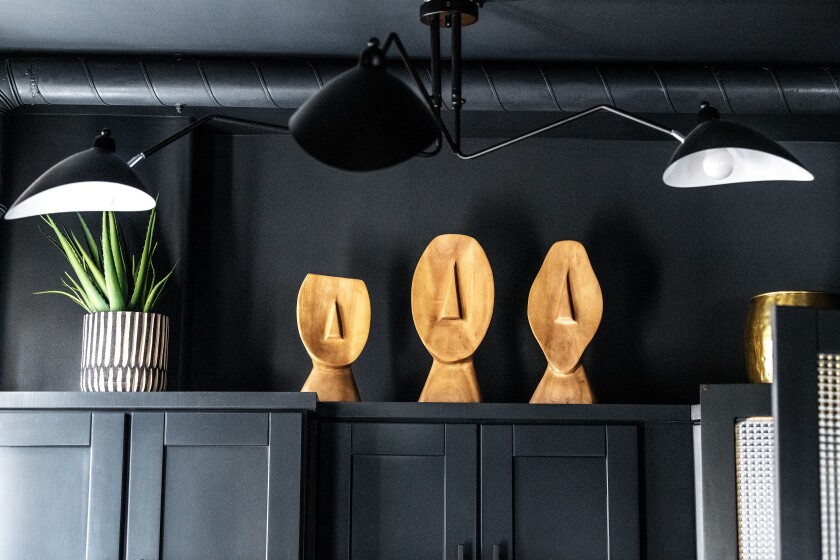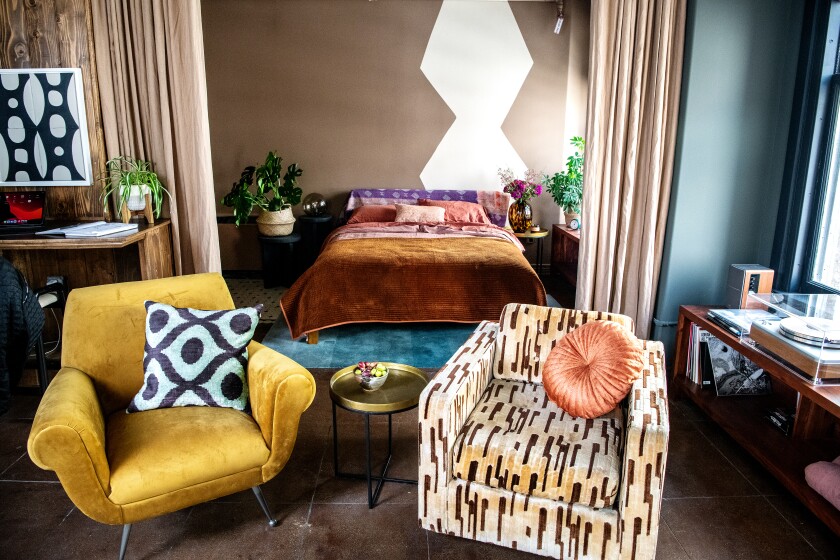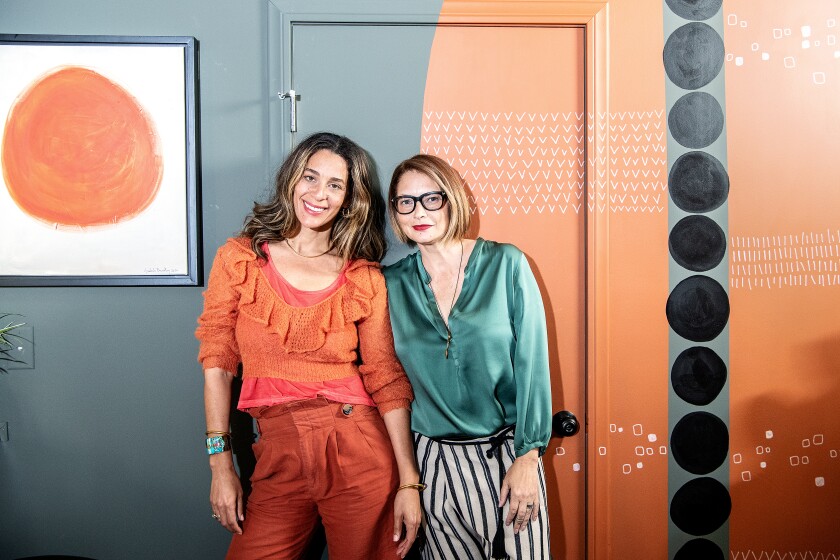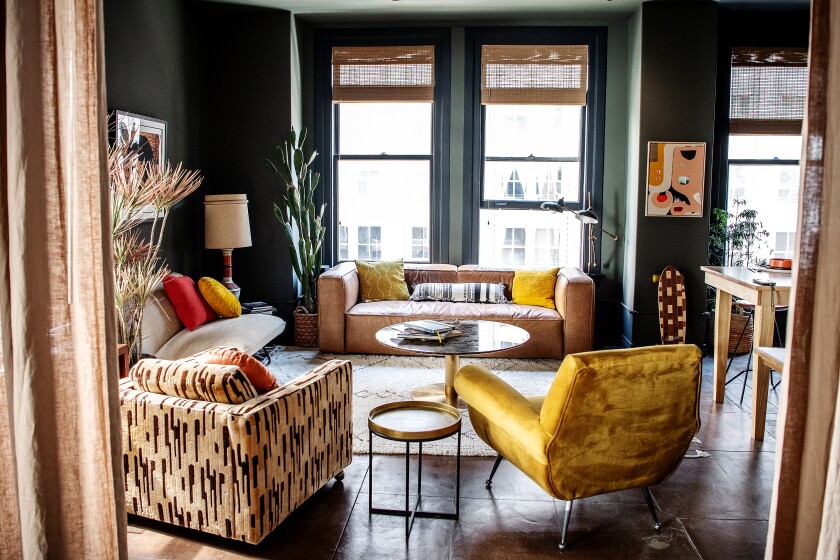Graced with funky Midcentury Modern lamps, crushed-velvet furnishings and African-inspired hand-painted murals, the downtown Los Angeles loft of Adrien Beard proves his assertion that “creativity is the equity” when it comes to nurturing innovative thinking.
As an artist, the third-generation Californian and Emmy-winning producer has worked in television (“South Park”), video games and films, but his most recent project exudes a distinctive African futuristic aesthetic that for him, feels personal.
“I didn’t want to make it the Black Panther headquarters,” says Beard, 50, who lives with his family in Altadena and plans to use the loft as a multipurpose space for work and community gatherings. “But I definitely wanted it to feel like if I got hit by a car tomorrow, people would know an African American lived in this space.”
Collaborating with high school friend and interior designer Sachiko Bradley — who also painted the stunning murals — and interior designer Faith Blakeney, the three artists say they have created a space and a wholly original style that is a true expression of Beard, his background and culture. They even invented a name for this fresh, futuristic aesthetic. They call it Neo Afro Eclecticism.
“Perhaps because we are all children of the ‘70s we wanted the space to have a funky element,” says Blakeney.
Like many native Angelenos, Beard’s appreciation for the loft and local history is tied to the cultural touchstones of downtown Los Angeles.
“My dad grew up in Santa Monica and said that when he was a kid, Clifton’s Cafeteria was the one place where Blacks were allowed in and treated well. My grandfather felt comfortable going there. In those days that was rare. The owner of Philippe’s loaned my parents money to buy their first house. He was a bank for the Black community. Wouldn’t it be great if people cared about others that way now?”
Not surprisingly, his loft is located in the historic heart of downtown Los Angeles, not far from Clifton’s. “I like the architecture,” he says. “It’s a corner unit and I love the natural light, the floors and the tile. I also love the fact that there is a burgeoning African American community in downtown Los Angeles.”
Back when he was a struggling artist during the ‘90s, Beard worked at the infamous all-night cafeteria Gorky’s Cafe and Russian Brewery when the streets of downtown Los Angeles were largely deserted. He recalls members of the Red Hot Chili Peppers lived nearby, south of the Arts District, and he and his friends would break in to the Bradbury Building and ride the landmark’s open-cage elevators. “We would go in using the fire escape,” he says with a laugh. “We were able to ride the elevators because the power was still on. Now, these places are selfie spots.”

African-inspired wood accessories in the kitchen.
(Mariah Tauger / Los Angeles Times)
Still drawn to downtown, Beard purchased the loft a year ago as an investment, just before COVID-19 was declared a pandemic.
Swamped with work, he hired the designers to give the loft an African-inspired but not cliched glow-up. The challenge for the designers seemed simple: transform the generic white loft into a warm and inviting environment where Beard could work and host artists in an intimate setting.
“Initially he sent us some images of New York-style lofts that he liked,” Bradley says. “But he gave us the freedom to find inspiration and edit out whatever we thought.”
But when the COVID-19 pandemic exploded, downtown Los Angeles became a ghost town and it was difficult for the designers to source furnishings for the project.
“It was almost post-apocalyptic,” Beard says.
“When I went online to shop, things were selling out at an unprecedented rate,” Blakeney says. “I’d pitch something to a client and it would be gone. The pandemic made people realize how important their homes are to them and how they impact their lives.”
It also prompted Bradley and Blakeney, who refer to themselves as “treasure hunters,” to get creative: Working outside their comfort zone, they went with a dark palette and graphic works of art, and used furnishings readily available on Facebook Marketplace and Etsy and at local thrift stores. “Thrift shopping is something we have both incorporated into our own lives,” says Bradley. “We are always on the hunt for treasures.”
With Beard determined to stay on a budget, the designers considered various approaches for creating a lounge-like environment before deciding on a dark and sultry color scheme: off-black walls with green and blue undertones, wood paneling on the building’s concrete column, and detailed hand-painted murals in warm orange and neutral tones that Bradley says remind her of Africa.
The designers incorporated several multipurpose concepts that will allow the loft to be used as a crash pad, community space, office, screening room and exhibition space. They enclosed the bedroom with floor-to-ceiling drapes installed on hospital-like tracks and installed a custom standing desk as part of the paneled cement column so Beard has a designated workspace. They also added a projection screen over the bed, should he ever want to host screenings.

When Beard wants to adapt the room, the curtains in the bedroom can be opened …
(Mariah Tauger / Los Angeles Times)

… or closed.
(Mariah Tauger / Los Angeles Times)
The designers kept costs down by retaining many of the loft’s original elements, including the cement floors and window treatments. In the kitchen, they modified the existing cabinets and painted the upper oak veneers black and the lower cabinets yellow for a fun surprise. They spent money on off-black thin brick Clé tiles and a custom butcher block drop-leaf countertop that can be folded to save space or extended for dining.
“We wanted to detract from the ugliness of the microwave and cabinets by making it all one color to create harmony,” Bradley says of the galley kitchen. A sexy black refrigerator completes the look.

The kitchen features black tile, yellow and black cabinets, and butcher block wood countertops.
(Mariah Tauger / Los Angeles Times)
In the living room, the loft’s bold wall and ceiling colors are enhanced by vintage accessories, art and comfortable furnishings: a leather sofa and Moroccan rug from Facebook Marketplace and armchairs in plush yellow velvet and a retro ‘70s pattern from the Hangar in Santa Monica.
When it came to the bathroom, Blakeney jokes that “no manner of paint could transform the space.” So they gutted the room and splurged on a sleek and sexy black ceramic Italian sink by Scarabeo, more off-black Clé tile in the shower, and whimsical black-and-white-patterned cement tile flooring. They also designed a custom cabinet to house the washer and dryer.

The bathroom of Adrien Beard’s loft in DTLA features a black sink and custom murals.
(Mariah Tauger / Los Angeles Times)
Growing up in Altadena and Orange County, Beard says he has always been captivated by the disparities that exist in Los Angeles. “I’ve lived here my whole life, and L.A. is still unique to me,” says Beard, who provides the voice of the character Token Black on “South Park.”
“People come here believing in their dreams, and yet you go downtown and see people who are struggling. I joke that in other cities, people drive to a destination. When you drive on the 105 freeway, you drive over stuff. L.A. is a weird compartmentalized place. It defeats the community. I feel like we see the pieces we only want to see.”
Inspired by independent filmmaker Ben Caldwell’s KAOS workshop in Leimert Park, Beard hopes to host small-scale salons where people of color can mingle with musicians, writers, artists and animators. “I want people to know that there’s an arts community here for them,” he says. “That’s what this space is about: bridging the gaps and community. I want people to share ideas and hopefully inspire each other and build community. If someone is struggling, I want them to know that people are here to help.”
Nobody knows this better than Beard. After excelling in art at El Toro High School, he attended ArtCenter College of Design, a Pasadena institution that has historically struggled with diversity. “I didn’t get that community at all,” Beard says. “It was all about how stylish you were. I didn’t have any money, so I couldn’t wear the things I was drawing in my fashion illustration classes. I had always been doing comic books and small videos on the side, so I switched to film and animation.”
He left ArtCenter and lived in his Volkswagen van until he landed some work for commercial director Joe Pytka. After saving some money, he applied to California Institute of the Arts, another institution of higher learning where Black students are underrepresented, and was accepted. Once again, he struggled to fit in. “I was accused of being an affirmative action kid,” he says. “Most Black students were at a disadvantage — Mark Bradford was there too — and they didn’t bring in any Black artists to bridge the gap for us. That’s one of the reasons why I hope this space can help artists of color.”
Bradley has seen Beard’s role as an advisor firsthand. “He’s been a mentor for young artists, including one of my youngest siblings,” she says. “He has helped them find their way to art school or helped them by advising them with their work choices.”
When he eventually hosts community gatherings in the loft, he hopes his guests will be able to “slide into the space” and feel at home.
“They did a magnificent job of creating a unique space,” Beard says of the designers. “They found so many gems and worked so hard to make it special. They were easy to talk to but were stern when they needed to educate me.”

Designers Faith Blakeney, left, and Sachiko Bradley stand in front of the bathroom in Adrien Beard’s DTLA loft.
(Mariah Tauger / Los Angeles Times)
Blakeney explains: “We told him he could have hardwood floors … or everything else he wanted. We managed to convince Adrien to keep the original floor — which was the first thing he wanted to redo — for the authenticity of the space.”
During the George Floyd protests downtown, the three of them spent many late nights in masks, discussing more than design and decor. “Sachiko is from Kathmandu. I was born in Berkeley. I didn’t know Sachiko was mixed like me,” Blakeney says. “It can be confusing. We were so isolated at the time, but the project brought the three of us together.”
Bradley thinks the emotions of those late-night talks influenced the project. “We took time to talk about our hopes and vision of the future,” she says. “We talked about how we hope the world will be for our children and what we could do to help bring change. This naturally inspired us to make some design choices that we felt dearly.”
While Beard admits he doesn’t want to be a spokesperson for the Black community, he says it’s meaningful for him to collaborate on a space where the aesthetics are inspired by that culture.
“It’s great that everyone wants to change things right now,” he says. “But there are still challenges to being heard as an African American artist. I hope this space is a way to deal with those challenges. I’ve never had the pleasure of working on a Black project. Young African American kids always ask me, ‘Where do I go to meet other artists of color?’ My goal is to say ‘downtown L.A.’”

Adrien Beard says he hopes the loft, with its walls painted a soft black with blue undertones, will become a place for meaningful collaboration.
(Mariah Tauger / Los Angeles Times)

